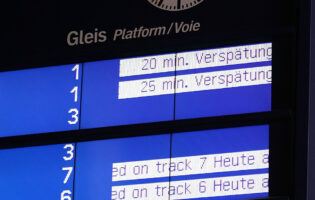The Impact of Educational and Exchange Programs on German-U.S. Relations

Rachel Seavey
MIT Senseable City Lab,
Rachel Seavey works as part of the management team at the MIT Senseable City Lab, where she assists a variety of international students and scholars, while managing the Lab’s admissions process, communications, and internal operations. As part of her role, she is responsible for helping coordinate the Lab’s annual Forum on Future Cities conference, which was cohosted by the World Economic Forum, the World Bank, and Mahindra in 2016. Rachel is a member of the Council of the German American Conference at Harvard e.V. and served as a CoChair for the German American Conference at Harvard in 2017. She also has experience working with U.S. and international students in the field of Student Affairs with offices of First Year Experience, Study Abroad, and Service-Learning. Before coming to MIT, Rachel oversaw 151 students studying abroad in Melbourne, Australia as an Assistant Site Director for Northeastern University’s N.U. in Program. She holds a Bachelor’s degree in Classics and a Master’s degree in Higher Education in Student Affairs.
She is a 2017-2018 participant in AICGS’ project “A German-American Dialogue of the Next Generation: Global Responsibility, Joint Engagement,” sponsored by the Transatlantik-Programm der Bundesrepublik Deutschland aus Mitteln des European Recovery Program (ERP) des Bundesministeriums für Wirtschaft und Energie (BMWi).
The U.S. Embassy in Germany claims that “foreign politics is no longer shaped primarily by government-to-government relations…public attitudes and opinions count” and today, educational and exchange programs established between the United States and Germany serve as some of the most influential forces shaping “public opinion.” Historically speaking, these programs have been immensely popular with students, scholars, professionals, and tourists, on both sides of the Atlantic. The German-American Fulbright Commission, for example, has sponsored over 300,000 scholarly exchanges since its creation in 1946. In 2011, the Obama administration reported that the United States was the top-ranked destination for German high school students studying abroad and that Germany was the top-ranked destination for American high school students studying abroad. And the Institute of International Education’s 2017 Open Doors Report lists Germany as one of the top five destinations for U.S. students studying abroad. Rankings aside, educational and international exchange programs possess an even greater responsibility: to invest and engage the next generation of young Germans and Americans, preparing them to deal with the global challenges of tomorrow.
Much has been written about the interpersonal benefits of participating in educational exchange programs, such as studying abroad, with long-term advantages that include the opportunity for individuals to immerse themselves within another cultural environment, improve foreign language skills, learn methods of communicating cross-culturally, develop greater autonomy and independence, establish a network that transcends national boundaries, and explore their own heritage and ancestral history. And study abroad is just one available path out of many; including international homestays, work-abroad programs, gap years, volunteering and service-learning programs, heritage tours, research and teaching fellowships, and bilateral programs. While participation in any form of educational and/or exchange opportunity often results in deep personal growth, long-term benefits ripple beyond individual participants, impacting families, friendships, networks, and professional and academic communities, and ultimately extending to foreign relations.
In my own professional experience within international education, I’ve witnessed, firsthand, how the experience of visiting, working, studying, and collaborating with another culture serves as a vehicle for personal and social change. Working in the study abroad office, where the university’s primary demographic was lower-income, first generation, and students of color, I saw many young people who were not only the first person in their family to go to college, but the first in their families to travel abroad and to directly interact with a culture not of their own—bringing back with them the customs, lessons, anecdotes, and insights they learned in a foreign country. Many of these students would later return to their host countries in their academic and professional careers, engaging in humanitarian efforts, seeking employment opportunities, pursuing advanced educational degrees, or further developing their interest and connection to the host culture and community. In another role, I worked abroad as an Assistant Site Director, supporting 151 college freshmen as they lived, studied, worked, and volunteered abroad, but also preparing them for careers in the international arena—whether it be in business, journalism, STEM fields, or public and international relations. Now at research lab at MIT, I’ve seen undergraduate and graduate students, scholars, professors, and researchers from all over the world collaborate on fundamental urban issues such as the future of mobility, the role of artificial intelligence, and public health crises such as air pollution or sewage. In each of these roles, I’ve seen how educational exchange programs yield the power to expand personal, academic, and professional possibilities, dispel cultural myths and stereotypes, build connections and cross-cultural relationships, contribute to innovation and world class research, and most importantly, challenge the notion that we cannot still find a way to coexist and collaborate with another despite our differences and disagreements.
In today’s ever-changing political climate, the German-American relationship needs these programs more than ever. While the German-American relationship is still seen as being paramount to global peace and the stability of the western world, many have been shaken by unforeseen political crises and claims that the German-American relationship is not as relevant as it once was. And yet, the 2016 U.S. Census Bureau found that “more than 40 million Americans claim German ancestry—more than any other group except the British,” a clear, connecting bond between our two countries. For the next generation of Germans and Americans, educational and exchange programs are imperative: we need more young Americans invested in Germany and more young Germans invested in America if our robust partnership is to continue to thrive. Young people need to believe in diplomacy, cooperation, and mutual respect—lessons learned firsthand by participating in education and exchange programs. Furthermore, it is not just what Americans or Germans, alone, see, feel, touch, and experience as a participant of educational exchange programs—it is what they bring back home with them, share among their communities, and carry with them the rest of their lives that impact our relations on a larger scale.









